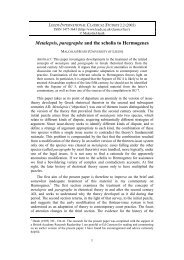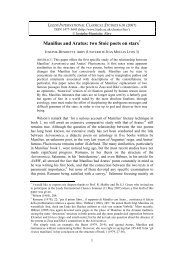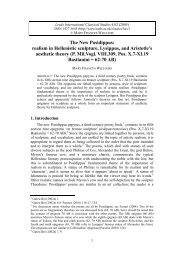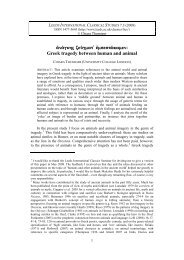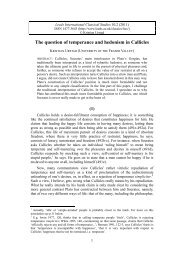Revisiting Tarpeia's myth in Propertius (IV, 4) - Leeds International ...
Revisiting Tarpeia's myth in Propertius (IV, 4) - Leeds International ...
Revisiting Tarpeia's myth in Propertius (IV, 4) - Leeds International ...
You also want an ePaper? Increase the reach of your titles
YUMPU automatically turns print PDFs into web optimized ePapers that Google loves.
MYRTO GARANI, REVISITING TARPEIA’S MYTH IN PROPERTIUS (<strong>IV</strong>, 4)<br />
Even before Vesta’s appearance <strong>in</strong> the elegy, Tarpeia is already th<strong>in</strong>k<strong>in</strong>g of<br />
possible ways to fulfil her erotic passion, which she unfolds <strong>in</strong> her long<br />
monologue (<strong>IV</strong>.4.31-66). As Wyke writes: ‘the Vestal virg<strong>in</strong> does br<strong>in</strong>g an erotic<br />
<strong>in</strong>terest to military matters... When Tarpeia expresses a desire to carry love <strong>in</strong>to<br />
military camps (<strong>in</strong> castra reponet amores, 37), she thus discloses the manner <strong>in</strong><br />
which the elegiac woman implements a requirement of the fourth book.’ 11 Yet,<br />
once Vesta takes action, she is the one who determ<strong>in</strong>es the outcome of the poem<br />
<strong>IV</strong> 4.67-70): 12<br />
dixit, et <strong>in</strong>certo permisit bracchia somno,<br />
nescia se furiis accubuisse nouis:<br />
nam Vesta, Iliacae felix tutela fauillae,<br />
culpam alit et plures condit <strong>in</strong> ossa faces.<br />
She f<strong>in</strong>ished speak<strong>in</strong>g and yielded her arms to fitful sleep, not know<strong>in</strong>g that she<br />
lay with new agents of madness: for Vesta, successful guardian of the Trojan<br />
embers, nurtures her fault and buries more torches <strong>in</strong> her bones.<br />
Accord<strong>in</strong>g to the standard <strong>in</strong>terpretation, Vesta embodies the pr<strong>in</strong>ciple of love,<br />
s<strong>in</strong>ce it is she who <strong>in</strong>stigates and nurtures Tarpeia’s s<strong>in</strong> (culpam alit, 70); <strong>in</strong> fact<br />
the flame that survives from Troy (Iliacae... favillae, 69) and assures Rome’s<br />
survival, becomes the flame of Tarpeia’s passion (faces, 70). From this moment<br />
on, Tarpeia is no longer <strong>in</strong> control of her behaviour. The role of Vesta <strong>in</strong> the elegy<br />
has been considered a real conundrum, s<strong>in</strong>ce this action seems irreconcilable with<br />
her virg<strong>in</strong>ity and her solemn profile. To quote Fantham: ‘Vesta symbolized several<br />
th<strong>in</strong>gs dear to Augustus: his Trojan ancestry, his role as avenger of his father Iulus,<br />
the chastity of his family, the perpetuity of his house.’ 13 That is why the name of<br />
Vesta <strong>in</strong> l<strong>in</strong>e 69, the standard read<strong>in</strong>g accord<strong>in</strong>g to the manuscript tradition, has<br />
even been doubted by some scholars and been replaced by that of Venus. 14 In<br />
Richardson’s words: ‘the fires and torches of love are the prov<strong>in</strong>ce of Venus and<br />
Amor, and for Vesta to arrogate them to herself to compass so cruel a purpose as<br />
the further undo<strong>in</strong>g of her votary is monstrous.’ 15 Not only, however, can this<br />
emendation be plausibly refuted, but <strong>in</strong> fact it is particularly reveal<strong>in</strong>g as regards<br />
the actual role of Vesta with<strong>in</strong> the poem.<br />
To beg<strong>in</strong> with, such a claim takes no notice of Vesta’s syncretism with Venus<br />
with<strong>in</strong> the broader framework of their assimilation ma<strong>in</strong>ly with Earth and then<br />
with other female goddesses. This syncretism is testified <strong>in</strong> several sources. For<br />
example, Varro <strong>in</strong> his Antiquitates Rerum Div<strong>in</strong>arum assimilates Tellus with<br />
several deities, among them Venus and Vesta (tellurem, <strong>in</strong>quit Varro, putant esse...<br />
Vestam, quod vestiatur herbis / They th<strong>in</strong>k, Varro says, that Tellus is... Vesta<br />
because she is ‘vested’ <strong>in</strong> flowers, fr. 268 Cardauns). 16 Given that <strong>Propertius</strong> turns<br />
11<br />
Wyke (1987a) 163.<br />
12<br />
Note that Heyworth (2007a) 163 changes Vesta to Venus.<br />
13<br />
Fantham (1983) 208.<br />
14<br />
Richardson (1977) 439; Goold (1990) 390; Heyworth (2007a) 163. On the other hand, see Fedeli<br />
(1994) 240, Hutch<strong>in</strong>son (2006) 38 who reta<strong>in</strong> the read<strong>in</strong>g Vesta.<br />
15<br />
Richardson (1977) 439.<br />
16<br />
Green (2002) 97, who discusses the association of Vesta with Venus <strong>in</strong> Ovid’s Fasti. Cf. also<br />
Varro Antiquitates Rerum Div<strong>in</strong>arum fr. 283 Cardauns (Aug. civ. 4.10 p.159.13): quis enim ferat,<br />
4



